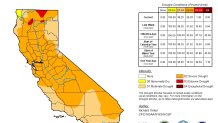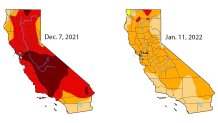January rain and snow in Northern California and ample snowpack from a series of early winter storms helped ease the worst drought conditions in California.
This week's U.S. Drought Monitor report shows no part of California in the most severe Drought Monitor category, known as exceptional drought. Three months ago, about 45 percent of the state was in exceptional drought.
Northern California received several inches of precipitation over the last week, adding to rain and snow from several storms in December.

Get a weekly recap of the latest San Francisco Bay Area housing news. Sign up for NBC Bay Area’s Housing Deconstructed newsletter.
This week's drought reports also shows improvement in other less severe categories. Extreme Drought, the second most severe category, was reduced to a few small patches in Northern California.
"Based on the abundant precipitation and ample snowpack observed so far this winter, improvement was brought into several areas," according to the Drought Monitor summary. "Most notably, most of the large D3 (extreme) area covering interior portions of northern and central California were reduced to D2 (severe)."
Nearly all of the state remains in moderate to severe drought.

“When we started December, we were in extreme drought conditions,” said NBCLA forecaster Belen De Leon. “But Mother Nature was good to us in December, we had storm after storm."
Droughts are common in California, where dry spells are often followed by wet winters that replenish the state's critical snowpack and water reservoirs. And it takes more than a lot of rain and snow in one shot to ease drought conditions.
The state is “definitely not out of the woods quite yet," said Sean de Guzman, manager of the snow surveys and water supply forecasting for the California Department of Water Resources.
Photos: December Storm Images From Around California
Prolonged hot and dry conditions over moths and years means water evaporates at a faster rate from reservoirs and the Sierra Nevada snowpack that feeds them. The snowpack usually melts in spring or early summer, then that water flows into the state’s vast storage and distribution system.
About a third of California's water supply comes from snow as it melts and flows down from the Sierra Nevada and the Shasta-Trinity mountain range in northern California.
California has more than 500 reservoirs, which were 50% lower than they should be at the start of June. These photos show the dramatic impact of the current dry spell at California’s lakes and reservoirs.
California's Mediterranean-style climate means the summers are always dry and the winters are not always wet. The state's reservoirs act as a savings account, storing water in the wet years to help the state survive during the dry ones.
Last year was the third driest on record in terms of precipitation.
Drought is generally defined as a period of drier-than-normal conditions resulting in water-related problems. That period can be days, weeks, months and years.
The term can have different meanings, depending on how water users are affected by water deficiencies. In a state of 40 million people, that's a lot of water users impacted in different ways by dry spells.
Droughts have been classified into the following:
- Meteorological drought means a lack of precipitation.
- Agricultural drought describes a lack of soil moisture.
- Hydrologic drought indicates reduced streamflow or groundwater levels.
California recently went through a five-year event from 2012-2016. Other notable historical droughts included 2007-09, 1987-92, 1976-77, and off-and-on dry spells of more than a decade in the 1920s and 1930s.



